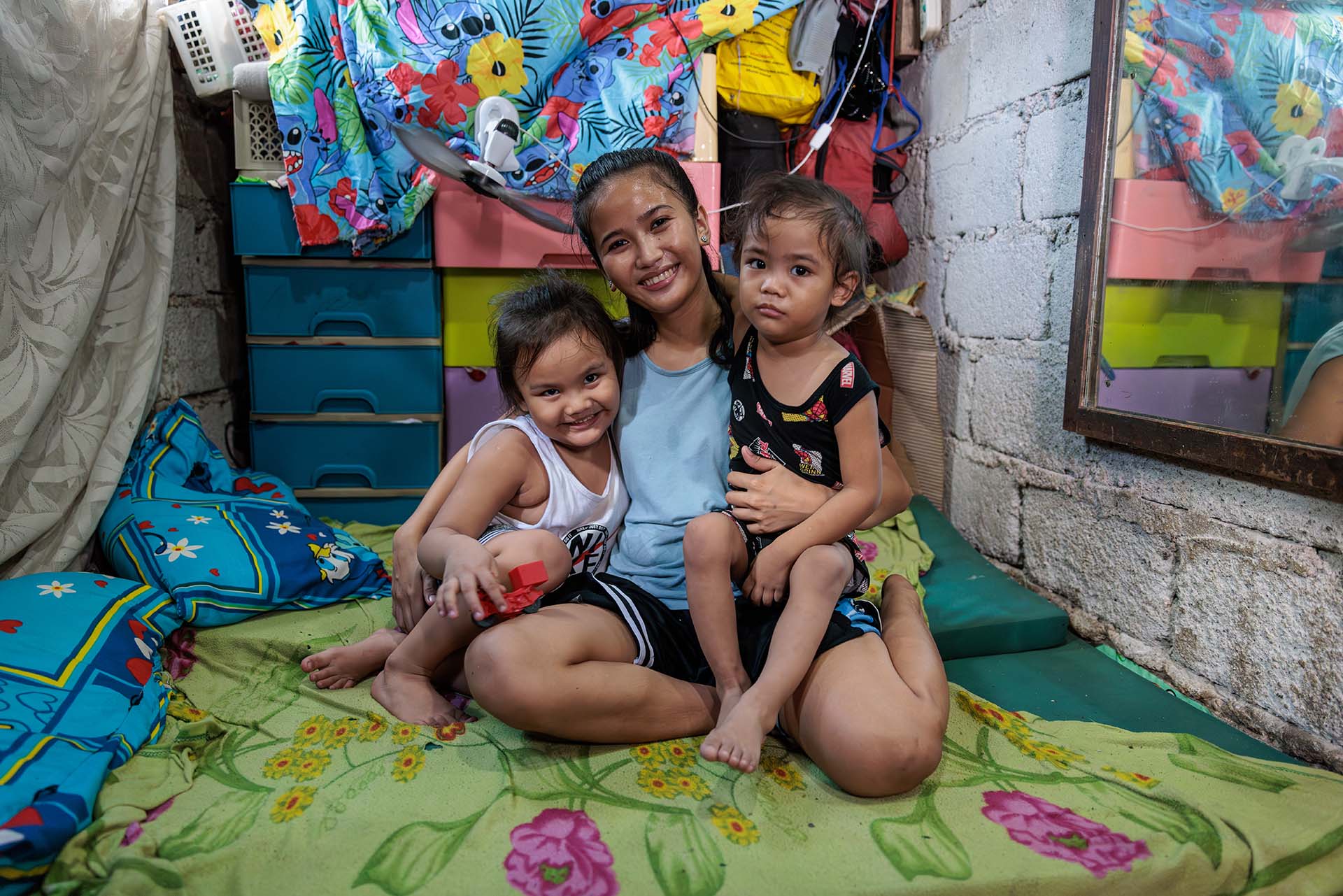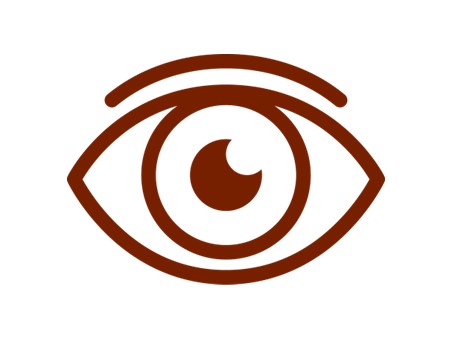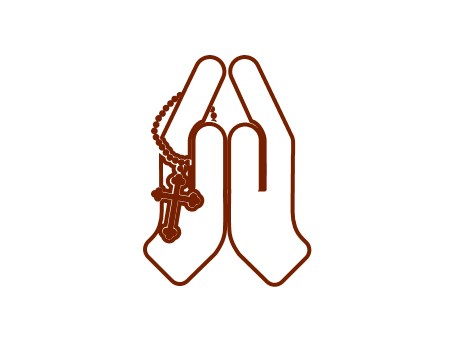Preferential Option for the Poor
Middle Primary
Why are people experiencing poverty?

Ronita (22) smiles as she holds her sons, Egzy Grey (3) and Clark (5), in their small home in Quezon City, Philippines. Photo: Richard Wainwright/Caritas Australia
Inquiry Question: Why are people experiencing poverty?
By the end of this unit, students will understand the root causes of poverty and why we should share what we have with others in need.
Before you start:
- Watch the Catholic Social Teaching (CST) film,‘Preferential Option for the Poor’
- for your own background knowledge and familiarise yourself with the ‘Preferential Option for the Poor’ poster.
- Download the various resources referenced at the bottom of this page (worksheets, slides etc.) Have the ready to go on your computer/interactive whiteboard.
- Read/watch the stories and videos linked in this learning sequence to determine if they are appropriate for your class.
- Locate any Scriptures and copies of Church texts (all hyperlinked within the learning sequence below).
- Read scripture commentaries (hyperlinked within the learning sequence below).
- Gather materials to build a tippy-tap (optional)
A note on talking about “the poor”: At Caritas Australia, we aim to communicate in an inspiring and respectful tone. Even though we are talking about people in difficult situations, it is important to emphasise human dignity and people’s strengths, their resilience and perseverance. It is more challenging to communicate such nuances to a younger audience, so at this level, we suggest starting to use language such as ‘’people living in poverty’ or ‘people experiencing poverty’ rather than ‘the poor’ or ‘poor people’ where possible, so as not to reduce people to the conditions they may be experiencing at the time.
See-Judge-Act-Pray Process
This learning sequence has been created using the ‘See, Judge and Act’ model.
This reflection–action process was first used by a Belgian Catholic priest, Joseph Cardijn (who later became a Cardinal) with Young Christian workers prior to the first World War. T
his approach was also recommended in the 1961 encyclical letter written by Pope John XXIII called Mater et Magistra (Mother and Teacher).
What is ‘Preferential Option for the Poor’?
- the act of prioritising the needs of the poor over the desires of the rich, the rights of workers over profits and the preservation of the environment over its exploitation
- a way of responding in love to the unjust circumstances in which millions of people live.
Student-friendly explanation:
- The Bible teaches us to take extra special care of the most vulnerable people in society.
- We should try to create a fairer world.
Learning intention
We are learning:
- identify causes of poverty
- explore how Caritas Australia can help people and/or communities
- listen and understand stories Jesus told
- explore how we can use our time, talents, and treasures to be able to support people experiencing poverty
- display love and respect to everyone.

SEE
Build: Use what you have. Do you have enough?
Students build a tippy tap or small house using materials provided by the teacher. Give some groups more than they need and others not enough. Make this obvious. When students ask for more materials, explain that is all you have and that you ran out. They will have to use what they have been given. (Alternatively, this site might be used to come up with a building to be constructed, if you are looking for another option.)
Debrief the activity. What were the challenges of the activity? What did each group do? Did they make do with what they were given? Did you take from someone else? Were you able to come up with another solution? What happened to their tippy tap or home? How did they feel? Reiterate that their feelings are valid and real, and it was ok to be upset or challenged. It was an activity, and it was not a real situation for them.
What is Poverty?
Introduce the video ‘No Poverty’, explaining that the video comes from the United Nations and No Poverty is the first of 17 goals called the Sustainable Development Goals, that the countries in the United Nations have set to be achieved by 2030.
· Watch No Poverty video
· After watching the video – Create a list of the causes of poverty explored in the video. Show students slide 19 of the Poverty (PPT). Compare the lists and see if there are any missing from their own list.
Exploring the Root Causes of Poverty
Have students break into groups of 2 or 3, select one of the causes of poverty listed and complete a consequences wheel considering the positive and negative consequences of their chosen or allocated cause. Discuss one as a class to model the activity for students.
Each group presents their consequences wheel to the class and discuss any questions or ideas other students have.
Explore Root Causes of Poverty (PPT) with students to develop the responses they provided and clarify their thinking.
Priscilla’s Story
Choose one or two photos from Priscilla’s story using this interactive image by clicking on the camera icon. Complete a See-Think-Wonder activity.
Watch or read Priscilla’s Story. Students answer the following questions:
- Why was it hard for Priscilla to grow enough food to feed her family?
- How did Caritas Australia help?
- How does Priscilla support her family now?
- How is Priscilla supporting others in her community?
- How will you share Priscilla’s story with others?
Other case studies you can explore include: Leaia (Samoa), Memory (Malawi) or Thu (Vietnam)

JUDGE
Scripture: The Good Samaritan
Teacher’s note: Teachers explore the Worlds of the Text here.
Read the Good Samaritan (Luke 10:25-37) to the students.
Ask some wondering questions to get the students thinking.
- I wonder if the man who was robbed had a name?
- I wonder what time of day it was?
- I wonder if the priest was a neighbour?
- I wonder if the Levite was a neighbour?
Invite the students to share their own wondering questions. (None of these need to be answered.)
In groups, students perform the Readers Theatre for The Good Samaritan. Use both this script and the Scripture reading to discuss the various characters in the story, what each one did and why.
Game: Knock ‘ems
With student assistance or in small groups stand dominoes or blocks up in a pattern and knock just one over. Discuss with the students what happens? Which blocks are affected? Highlight the point that all are affected in some way. This is the same with people.
How is this idea the same or different to the story of the Good Samaritan? What we do in one place affects another. What we do to one person can often not only affect them but others also: both positively and negatively.
In the story of the Good Samaritan, Jesus asked the question, “Who is my neighbour?”
Ask, ‘Who are our neighbours in the world today?’ Locally, nationally and internationally. Students Turn and Talk in groups of three or Think, Pair, Share.
What does the Church say?
The Catholic Church has some principles to guide us. One of them is the Preferential Option for the Poor. Our Church teaches us that people who do not have what they need, such as food, water, work, housing, school, medical care must be treated with extra respect and given what they need. Those of us who are not poor must share what we have with those who are.
Display the Preferential Option for the Poor Poster and discuss what ‘Preferential’ means. Preferential is about preferring, option is about choosing, the poor – considering the needs of the poorest first.
The quote at the bottom from Pope Francis comes from his letter Fratelli Tutti (Fratelli Tutti means “all brothers and sisters”).
“The Samaritan who stopped along the way departed without expecting any recognition or gratitude. His effort to assist another person gave him great satisfaction in life and before his God, and thus became a duty. All of us have a responsibility for the wounded, those of our own people and all the peoples of the earth. Let us care for the needs of every man and woman, young and old, with the same fraternal spirit of care and closeness that marked the Good Samaritan.” (n79)
Considering the meaning of the Preferential Option for the Poor and this passage by Pope Francis, student think about how the Good Samaritan demonstrated a preferential option for the poor and Think-Pair-Share.
Students identify what the icons in the heart represent and why they think the icons were used.
Students reflect on their learning about poverty and the Preferential Option for the Poor to date, and complete an I Used To Think, Now I Think activity about what they have covered so far.

Act
Story: The Rainbow Fish
Read The Rainbow Fish or watch it being read here.
Discuss what the Rainbow Fish did throughout the story and what eventually led the other fish to play with him.
Teacher’s Note: The object is to have the students come to the understanding that he needed to share what he had and not keep everything to himself.
How to give: Time, Talent, and Treasure
Have students reflect on what they have learnt so far about poverty and its causes.
Explain that we could record the way that we can help or give under three different headings – time, talents, and treasure. As a class or in small groups students discuss and record ways they can use their time, talents, or treasures to make a difference in the lives of people affected by poverty. Support students to implement one of their ideas.
Extension: Students create a proposal for one of their ideas for an assessment, answering: What is your idea? Who is it for? When could it be done? Where would it take place? How will it work? Why is it a solution to poverty?

Pray
Complete one of the prayer experiences listed.
Class Prayer Experience:
Prepare: organise prayer materials for prayer space (electric candle, bible, cross/crucifix, material), pieces of paper and pencils for students to write their commitments. Quiet instrumental music.
Students sit in a circle and/or facing towards the prayer space (if possible).
Begin with the sign of the cross
Teacher ask students to take a moment to think about what they learnt about the issue of poverty and the inquiry question: Why are people experiencing poverty?
After a short while, invite students to share one thing they learnt.
Explain that we spoke about displaying love and respect to everyone and everything. Invite students to write down two commitments they are going to make to show love and respect to everyone and/or everything. Ask them to place their commitments in the prayer space.
Pray (Teacher or student)
Dear God,
We, here in (insert class name), thank you for helping us to understand why people are living in poverty and encourage us to share our learning with others. Today we have all made commitments to use our time, talent or treasure to display love and respect to people in different ways, sharing what we have to make a better world. Help us with our commitments so that we can be a good example to others, like Jesus is to us.
Amen
Conclude with a song. For example:
- These Hands - Andrew Chinn
- Do Something – Matthew West












